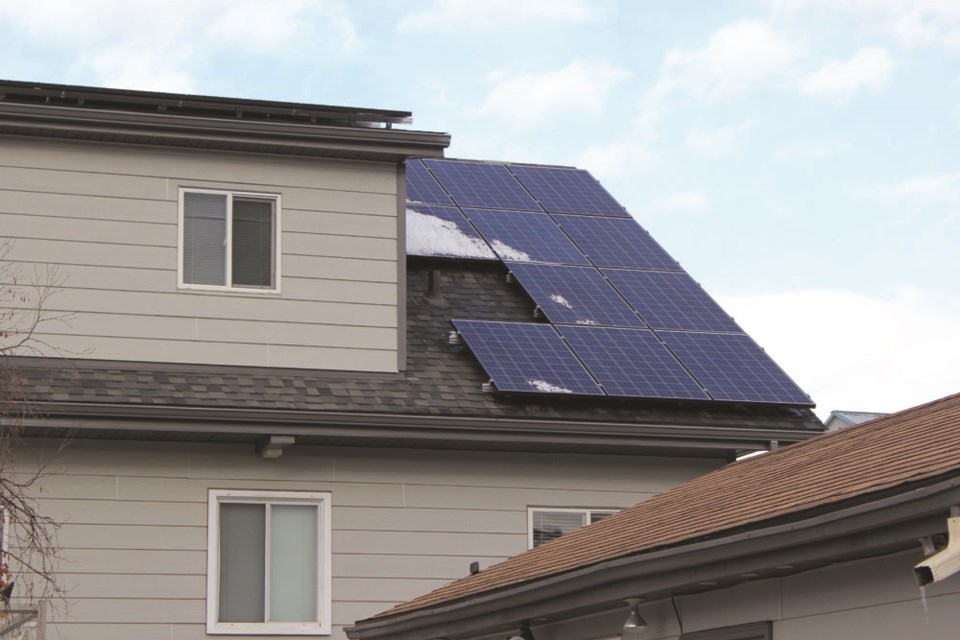
When Candice Davis and her husband Mike Horvath first heard about the benefits of installing solar panels on their roof, the local family jumped at the bright idea.
The family of five recently installed 32 photovoltaic (PV) solar panels on their roof in a bid to cut down their energy costs and reduce their ecological footprint.
According to Davis, the panels will generate more than enough electricity to power their home, essentially eliminating their power bill all together and making them a net producer instead of a consumer.
“It just made sense,” Davis said, following a presentation about solar power at the Jasper Royal Canadian Legion, Nov. 19.
According to Davis, her family spent less than $30,000 to install the solar panels, which she said they expect to pay off in eight years.
Randall Benson, owner of Gridworks Energy Group, which installed the family’s solar PV system and hosted the presentation, said the biggest thing holding people back from adopting solar energy is misinformation.
To debunk some of those myths he presented various facts and figures, all of which pointed to the same conclusion–solar power is not only the most abundant energy source in the world, it’s free and it’s economically viable.
“We could power all of Alberta’s needs hundreds of times over with just solar energy,” said Benson.
“And the best part is it’s free. It’s a one-time cost for your electricity. You put the solar PV system on your roof and that is it. You don’t have to pay for it unlike natural gas or coal fired electricity.”
The majority of his presentation focused on the financial costs.
“If you install a solar PV system on your roof and you’re generating your own electricity, thus negating your power bill, there’s an immediate return on investment,” explained Benson. “You can keep that money in your pocket.”
He also dismissed myths about the life span and quality of solar panels.
“Companies are offering up to 40-year warranties these days, even the inverters have 25-year warranties on them,” said Benson. “How many of you have heard of 25- or 40-year warranties on anything?”
According to Benson, the most common solar PV system is a grid-connected system that allows people to feed electricity back to the system.
“When there’s a site shortage you’re buying from the grid, when there’s a site surplus you’re selling to the grid,” explained Benson.
Locally, both Benson and Davis said Parks Canada and ATCO Electric were very easy to work with.
“Everything went very, very smoothly. Dealing with ATCO has been super and dealing with Parks Canada has been fantastic because they are very for it,” said Davis.
“I think everyone knows this is the direction we’re going and I think everyone wants it to go as smoothly as possible.”
She said the solar panels haven’t increased her house insurance and could in fact increase its property value.
While installing a grid-connected PV system sounds enticing, Benson acknowledged the up-front costs can be a daunting, but stressed that the costs are falling between 10 and 15 per cent every year.
For example, a six-kilowatt grid-connected system would cost between $18,000 and $19,000. Seven years ago it would have cost $60,000, according to Benson.
“The costs of these systems have dropped about 70 to 80 per cent over the last 10 years.”
He also emphasized the economic and environmental benefits of going solar.
“The return on the environment is immediate. Once we turn that system on for you there’s much less coal being burned, much less natural gas being burned for that electricity,” said Benson.
In September the provincial government announced 30 per cent of electricity used in Alberta will come from renewable sources such as wind, hydro and solar by 2030.
“That means all coal-fired generation in Alberta is going to be shut down by 2030 and a large portion of it is going to be by 2019 and solar and wind is going to take over,” said Benson.
Paul Clarke
[email protected]
